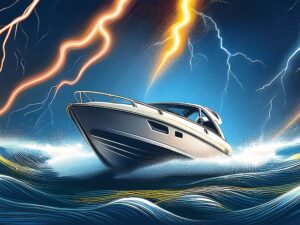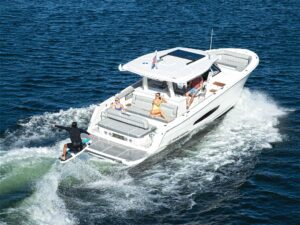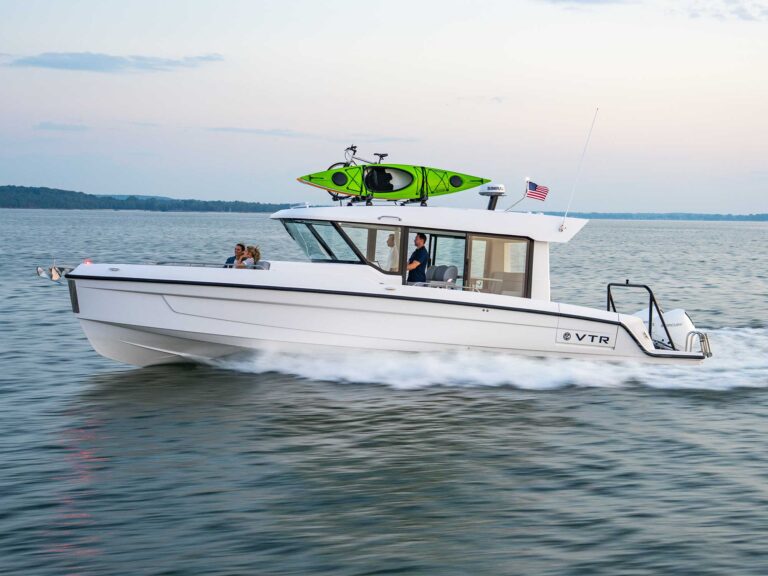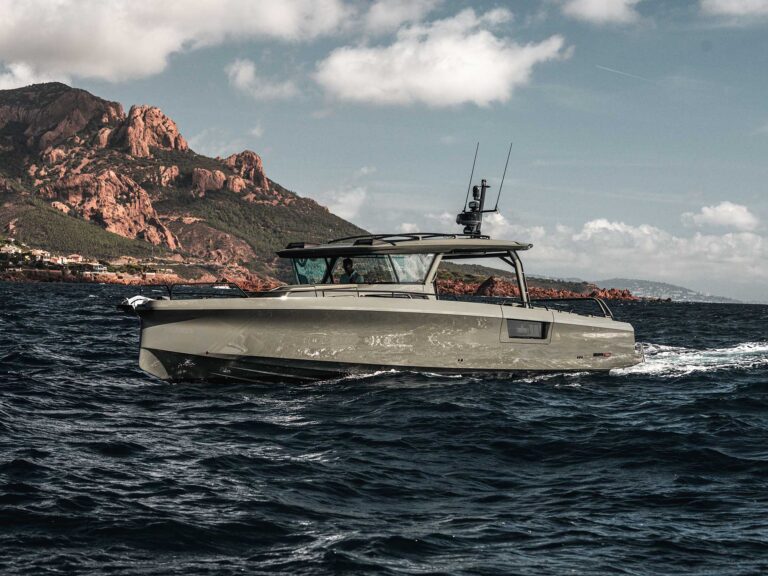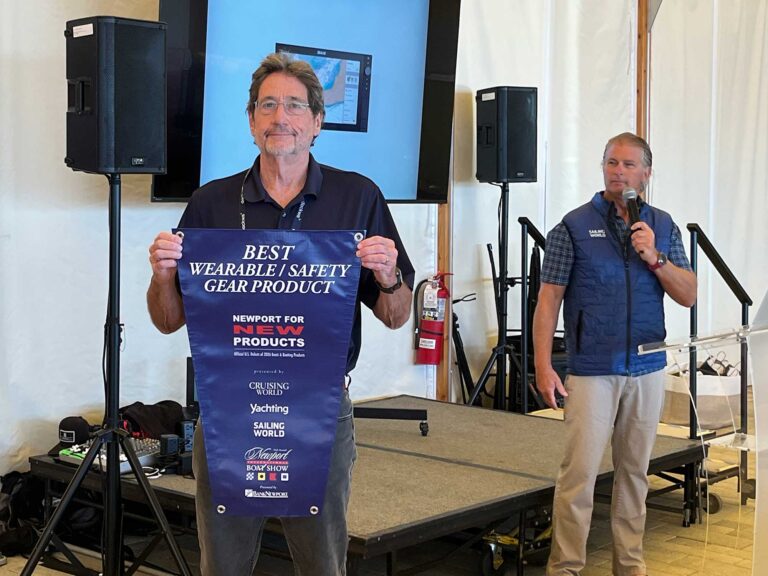Designing a pontoon boat has become a real “keep up with the Joneses” proposition. This segment evolves at a break-the-neck pace as builders continue to up the ante in performance, luxury and features. The all-new Harris Solstice 250 is an example of a builder combining creativity and agility to keep the heart of its lineup fresh and current.

Overview
In Harris parlance, a pontoon boat has two main components. The chassis refers to the pontoons, the deck and the structure that mates them together, while the playpen refers to any part of the boat within the fencing. In creating the new Solstice 250, Harris redesigned both of these elements. The standard Solstice 250 chassis features two 25-inch-diameter tubes constructed in 0.08-gauge aluminum with a rear skin over the cross members and a 28-gallon fuel tank. Our test-boat chassis is Performance Level 3.5 ($8,885), one of four upgrade options, which includes triple 27-inch-diameter tubes constructed in 0.09-gauge aluminum with reinforced nose cones, lifting strakes, a skin kit to the front cross member, and a generous 63-gallon fuel tank placed in the center tube. Harris says the new chassis adds baffles to stiffen the tubes, and optimizes the shape of the lifting strakes to improve fuel economy. Harris requires a three-tube chassis for any outboard option over 200 hp, including the Mercury Verado 300 on our test boat. The triple-tube chassis improves handling because the boat will track through a turn on that center tube, and it rides better in rough water by adding buoyancy and raising the boat a little higher above the surface. The outboard mounting bracket is attached to that center tube to better transfer power.

Interior and Accessories
In redesigning the Solstice 250, Harris moved the playpen—and thus all of the accommodations—forward on the deck 10 inches from the model it replaces, and extended the aft platform by 8 inches. Harris says moving the playpen forward improves the boat’s fore-aft balance (especially with the largest outboards, we are guessing) and its performance. Aft deck space increases by 68 percent, and the platform now extends farther around the outboard, moving the boarding ladder farther from the prop for an improved swimming experience. The decking is treated plywood with tongue-and-groove seams sealed top and bottom with butyl rubber tape. A full-length M-channel rests on top of the tubes to support the deck. The patented Harris rub rail attaches to cross members rather than the edge of the plywood decking, so a solid bump on the rail won’t damage the deck. All structural components of the boat are covered by a lifetime warranty.

Our test model has the SLEC floor plan option ($3,375), which denotes the single aft lounge (SL) and the entertainment center (EC). The aft lounge is new, with a pivoting backrest for seating facing fore or aft, or lay it flat to create a full sun lounge. The aft portion of the bottom cushion can also be inclined, and the fiberglass base incorporates stowage and a built-in cooler. The entire interior of the Solstice line has been restyled for 2020 with a more contemporary look. The entertainment center is a fiberglass console amidships to port, with a sink below a lid in the top and space for an optional stainless-steel refrigerator ($2,125) below.
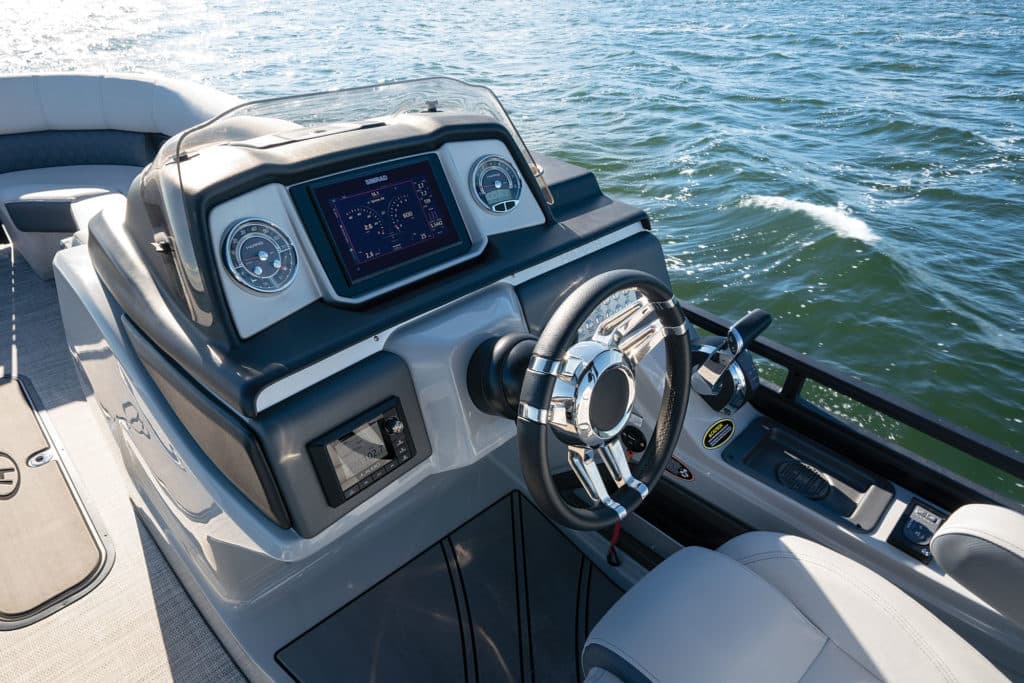
The optional raised helm ($800) moves the seat about 6 inches higher to give the captain a better view. The optional Simrad G09 9-inch fish finder/navigation display ($1,660) fills the center of the dash, and a VesselView link ($885) transmits SmartCraft engine data and Mercury Active Trim control ($955) to the screen. Another new feature is a flip-top on the helm console that provides excellent access to all of the electronics and wiring within—it sure beats lying on your back under the helm. The most expensive option on our test boat is the new Evo 2.0 tower ($15,075), a handsome black aluminum arch with powered lift and sun top.
Learn more about the 300-hp Mercury Outboard that powered this boat!
Engine
While no-waking our way out of the harbor, we were struck by the utterly smooth and quiet operation of the new V-8 Mercury Verado 300 outboard. In a pontoon application, this motor just disappears—until you drop the throttle, and there’s a rush of silent power moving the boat forward with urgency. Cruising along at about 20 mph, the Solstice 250 offers a sublime pontoon experience—just enough breeze for comfort, no engine noise, and a stable ride that allows passengers to move around the boat with confidence. The ride on a choppy lake was outstanding, and the Solstice turns on a dime, with no sensation of flex in the chassis.

Solstice is the midrange line from Harris, and base price with the Mercury Verado 300 and required Performance 3.5 chassis is about $95,000. A long list of options took the price of our test boat to about $138,000, a sum that would have been eye-popping for a pontoon a few years ago, but today seems like a good value for this level of comfort, style and performance, all underpinned by solid design.
How We Tested
- Engine: Single Mercury Verado 300
- Drive/Prop: Outboard/Mercury Enertia 14.2″ x 18″ 3-blade stainless steel
- Gear Ratio: 1.85:1 Fuel Load: 63 gal. Crew Weight: 370 lb.
High Points
- Flip-top helm console provides excellent service access to wiring, electronics and steering components.
- Solid construction details in a chassis that should stay tight and flex-free season after season, even with a big outboard on the transom.
- Create your perfect pontoon with an extensive list of options.
Low Points
- Extensive list of options is mind-boggling.
Pricing and Specs
| Price: | $94,633 (base with test power) |
|---|---|
| LOA: | 27’11” |
| Beam: | 8’6″ |
| Draft (max): | 1’9″ |
| Displacement (approx.): | 3,770 lb. (without power) |
| Transom Deadrise: | NA |
| Bridge Clearance: | 6’11” (with tower) |
| Fuel Capacity: | 63 gal. |
| Max Horsepower: | 400 |
| Available Power: | Mercury and Honda outboards up to 400 hp |
Speed, Efficiency, Operation

Harris – Fort Wayne, Indiana; 260-432-4555; harrisboats.com


